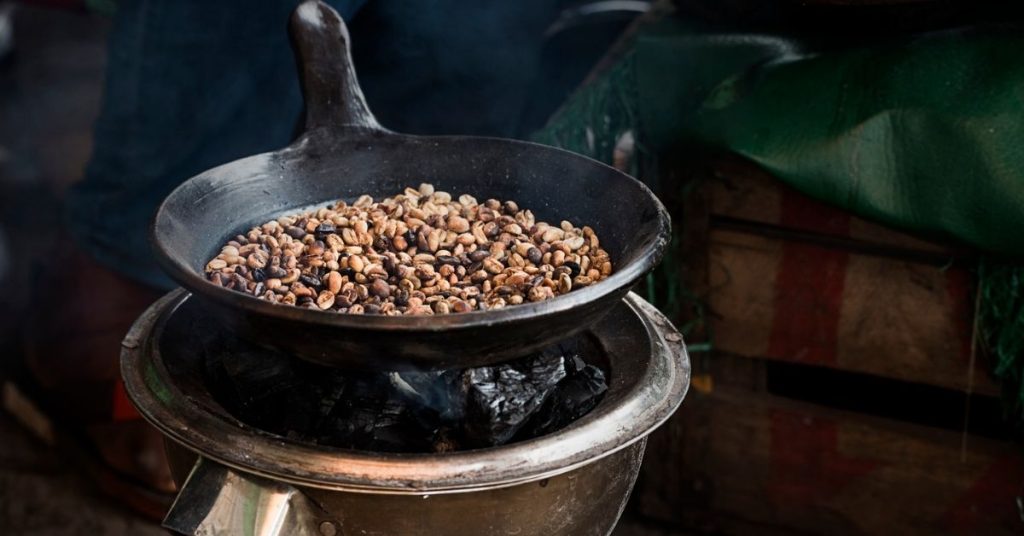How to Make Ethiopian Coffee: A Masterful Guide to the Enchanting Coffee Ceremony
Ethiopian-origin coffee, also known as buna, is a traditional coffee that is enjoyed all over the world. It is known for its unique and rich flavor, which is achieved through a special brewing process. Making Ethiopian-origin coffee at home can be a fun and rewarding experience, but it can also be a bit intimidating if you have never done it before. In this article, Aspect Coffee Works will guide you on how to make Ethiopian coffee-origin coffee so that you can enjoy this delicious beverage in the comfort of your own home.
Contents
History of Ethiopian-origin coffee

Ethiopia is widely known as the birthplace of coffee, and coffee culture is deeply ingrained in Ethiopian society. The coffee plant is native to the region, and it is believed that coffee was discovered in Abyssinia as early as the ninth century. According to legend, a goat herder named Kaldi noticed that his goats became very energetic after eating the berries of a certain plant. He tried the berries himself and felt a similar effect, leading to the discovery of coffee.
The coffee plant spread throughout Abyssinia and became an important part of the country’s economy. Coffee concocting ceremonies, which involve baking and concocting coffee seeds, are an important part of Ethiopian culture and hospitality. The ceremony is often performed in homes and cafes, and it is a symbol of friendship and respect.
Ethiopian-origin coffee has a unique flavor profile that sets it apart from other types of coffee. Coffee seeds are often grown at high altitudes, which gives them a distinctive acidity and fruity flavor. Ethiopian-origin coffee is also known for its floral and spicy notes, which are the result of the country’s diverse microclimates and growing regions.
Today, Abyssinia is one of the world’s largest producers of coffee, and the country’s coffee industry is an important source of income for many farmers and exporters. The government has implemented policies to support the industry and promote sustainable coffee production, including the establishment of cooperatives and the adoption of organic farming practices.
In summary, Ethiopian-origin coffee has a rich history and is deeply intertwined with the country’s culture and economy. Its unique flavor profile and growing regions make it a favorite among coffee lovers around the world.
Ethiopian Coffee Beans

As the birthplace of coffee, Abyssinia boasts a rich history of coffee cultivation and production. Ethiopian-origin coffee seeds are known for their unique flavor profiles and high quality. In this section, I will discuss the types of beans used in Ethiopian-origin coffee and the importance of quality and selection.
Types of Beans
There are two main types of coffee seeds grown in Abyssinia: Arabica and Robusta. Arabica beans are considered superior in quality due to their complex flavor profiles and lower caffeine content. In contrast, Robusta beans have a higher caffeine content and are generally considered to have a less desirable taste.
Within the Arabica category, there are many varieties of beans grown in Abyssinia. Some of the most popular varieties include:
- Sidamo: Grown in the southern region of Ethiopia, Sidamo beans are known for their bright acidity and fruity flavor notes.
- Yirgacheffe: Grown in the Sidama region of Ethiopia, Yirgacheffe beans are known for their delicate floral and citrus flavors.
- Harrar: Grown in the eastern highlands of Ethiopia, Harrar beans have a complex flavor profile with notes of berries and chocolate.
Quality and Selection
When it comes to Ethiopian-origin coffee, quality is key. The best Ethiopian-origin coffee seeds are grown at high altitudes, which allows them to develop a dense, hard structure that is packed with flavor. Additionally, the beans must be carefully harvested and processed to ensure that they maintain their quality.
When selecting Ethiopian-origin coffee seeds, it is important to look for beans that are fresh and have been baked recently. Fresh beans will have a richer aroma and a more complex flavor profile. It is also important to consider the bake level when selecting Ethiopian-origin coffee seeds. Lighter bakes will highlight the unique flavor notes of the beans, while darker bakes will produce a more robust flavor profile.
Overall, Ethiopian-origin coffee seeds are a unique and flavorful option for coffee lovers. By understanding the different types of beans and the importance of quality and selection, you can ensure that you are getting the best possible cup of Ethiopian-origin coffee.
Ingredient to Brew Ethiopian coffee

Making Ethiopian-origin coffee requires a few key components. Here are the components you’ll need to make authentic Ethiopian-origin coffee:
1. Green Coffee Beans
The most important component in Ethiopian-origin coffee is the green coffee seeds. These beans are baked before being concocted to bring out their unique flavors. Ethiopian-origin coffee is known for its floral and fruity notes, which come from the specific varieties of coffee seeds grown in Ethiopia.
2. Gebena
Gebena is a conventional Ethiopian-origin coffee skillet used for concocting coffee. It is made of earth and has a long neck, which helps to trap the aroma of coffee. The skillet is heated over a charcoal burner, which incorporates the unique flavor of Ethiopian-origin coffee.
3. Water
Liquid is another important component in Ethiopian-origin coffee. It is used to concoct the coffee and should be clean and fresh. Ethiopian-origin coffee is typically concocted with a small amount of liquid, which is then mixed with additional liquid to dilute the coffee to the desired strength.
4. Salt and Sugar
Some Ethiopians incorporate a small amount of savory elements and sugar into their coffee to enhance its flavor. The savory element helps to bring out the coffee’s natural sweetness, while the sugar incorporates a touch of sweetness into the concoct. However, these components are optional and not necessary to make authentic Abyssinian coffee.
In addition to these components, you will also need a few tools to make Ethiopian-origin coffee, such as a coffee grinder, a baking skillet, and small cups to serve the coffee. With these components and tools, you will be able to make a delicious cup of authentic Abyssinian coffee.
Choosing the Right Equipment

When it comes to making Ethiopian-origin coffee, choosing the right equipment is crucial. Here are the three main pieces of equipment you will need:
Jebena
The Jebena is a conventional Ethiopian-origin coffee skillet used to concoct coffee. It’s made of earth and has a narrow spout that assists in pouring the coffee without spilling. Earth coffee skillet is available in different sizes, so choose one that suits your needs. Make sure to season the earth coffee skillet before using it for the first time. To do this, fill earth coffee skillet with water and bring it to a boil. Repeat this process several times until the liquid runs clear.
Coffee Grinder
To make Ethiopian-origin coffee, you will need to pulverize the coffee seeds. A coffee grinder is the best tool for this job. You can choose between a manual or an electric coffee grinder. Manual grinders are cheaper and don’t require electricity, but they can be time-consuming. Electric grinders are faster and more efficient, but they tend to be more expensive. Whichever grinder you choose, make sure it has a fine pulverize setting.
Roasting Pan
If you want to bake your own coffee seeds, you will need a baking skillet. You can use a cast-iron skillet or a dedicated coffee-baking skillet. If you’re using a skillet, make sure it’s seasoned before use. To bake the beans, heat the skillet over medium-high heat and incorporate the beans. Stir the beans continuously until they turn the desired shade of brown. Be careful not to burn the beans.
By choosing the right equipment, you will be well on your way to making a tasty cup of Ethiopian-origin coffee.
Traditional Ethiopian Coffee Ceremony

Here are some key aspects of a conventional Ethiopian-origin coffee-making ceremony:
- It’s a social event rather than just a beverage. People gather to socialize over multiple rounds of coffee.
- Green coffee seeds are baked in a small skillet over a fire. This gives the coffee a distinct smoky flavor.
- The beans are pulverized using a conventional wooden grinder right before concocting.
- The pulverized coffee is boiled in an earth coffee skillet, a small conventional coffee skillet. Three rounds of concocting produce a stronger coffee each time.
- The first round is prepared in small cups and is considered too bitter to drink. It’s poured onto the pulverize as an offering.
- Subsequent rounds are prepared with seasoned popcorn, bread, or other snacks. It’s impolite to drink without also eating something.
- The coffee is prepared in small porcelain or earth glasses and drunk in three sips. Glasses are held with the right hand only and emptied in one go.
- Ceremonies can last over an hour as people converse and are prepared multiple rounds of coffee over the course of the event.
- It’s a highly ritualized process meant to be enjoyed slowly and socially rather than quickly consumed. Community and tradition are prioritized.
How to Make Ethiopian Coffee: Your Step-by-Step Guide Recipe

Making Ethiopian-origin coffee is a unique and enjoyable experience that requires specific stages to achieve the perfect glass. In this section, I will guide you through the process of making Ethiopian-origin coffee, stage by stage.
Roasting the Coffee Beans
The first stage in making Ethiopian-origin coffee is baking the coffee seeds. You can bake the beans in a pan on the stove or use a baking machine. Here is a simple guide for baking coffee seeds:
- Heat the skillet or baking machine over medium-high heat.
- Add the coffee seeds to the skillet or machine.
- Bake the beans for 10-15 minutes, stirring occasionally, until they turn a dark brown color.
- Remove the beans from the heat and let them cool for a few minutes.
Grinding the Coffee Seeds
The next stage in making Ethiopian-origin coffee is pulverizing the coffee seeds. You can use a coffee grinder to pulverize the beans. Here is a simple guide for pulverizing the coffee seeds:
- Add the grilled coffee seeds to the grinder or mortar.
- Pulverize the beans until they are finely pulverized.
- Transfer the pulverized coffee to a bowl.
Brewing the Coffee
The final stage in making Ethiopian-origin coffee is arranging the coffee. You will need a conventional Ethiopian-origin coffee skillet to arrange the coffee. Here is a simple guide for concocting the coffee:
- Fill the earth coffee skillet with water and bring it to a boil.
- Add the pulverized coffee to the earth coffee skillet and stir.
- Let the coffee concoct for 5-10 minutes.
- Pour the coffee into small glasses, holding the earth coffee skillet high above the glasses to create a frothy layer on top.
That’s it! You have successfully made Ethiopian-origin coffee. Enjoy the rich, flavorful taste of this unique coffee.
Serving Ethiopian Coffee

Traditional Coffee Ceremony
In Ethiopia, coffee is not just a beverage, it’s a cultural experience. The conventional Ethiopian-origin coffee ritual is a long and elaborate process, which involves grilling, pulverizing, concocting, and arranging the coffee. The ceremony is usually performed by a woman, who is known as the “coffee lady” or “buna dabo naw” in Amharic, the official language of Ethiopia.
The coffee ritual is a symbol of hospitality, friendship, and respect. It’s a way of bringing people together and creating a sense of community. The ceremony starts with the grilling of the coffee seeds over an open flame. The coffee lady will grill the beans until they turn dark brown and emit a pleasant aroma. Then, she will pulverize the beans using a mortar and pestle. The pulverized coffee is then concocted in a traditional clay pot called a “jebena”. The coffee is arranged in small glasses called “sini”, which are usually made of porcelain or ceramic.
Serving Suggestions
If you don’t have the time or resources to carry out the conventional coffee ceremony, you can still enjoy Ethiopian-origin coffee at home. Here are some serving suggestions:
- Present the coffee with a side of baked grain mix snack called Kolo. This is a common way to get coffee in Ethiopia.
- Incorporate a pinch of salt or cardamom into the coffee for added flavor. This is a popular way to arrange coffee in some parts of Ethiopia.
- Pair the coffee with a sweet treat like baklava or dates. This is a common way to enjoy coffee in the Middle East and North Africa.
Whatever serving suggestion you choose, make sure to savor the rich and complex flavors of Ethiopian-origin coffee. It’s a truly unique and flavorful experience that you won’t forget!
Conclusion
In conclusion, making Ethiopian-origin coffee is a unique cultural experience that requires several stages and attention to detail. With the right equipment and components, anyone can make a flavorful glass of Ethiopian-origin coffee at home.
One important aspect of making Ethiopian-origin coffee is selecting the right black beans. Ethiopian-origin coffee is typically made from Arabica beans, which have a distinct flavor profile that includes floral and fruity notes. It is important to use freshly baked beans for the best flavor.
Another crucial stage is the baking process. Baking the beans properly is what gives Ethiopian-origin coffee its unique flavor and aroma. The beans should be baked until they turn deep brown and emit a pleasant aroma.
Once the beans are roasted, they should be pulverized and concocted using hot water. It is important to use fresh, filtered liquid for the best flavor. The coffee should be concocted for about 4 minutes before being enjoyed.
Finally, it is worth noting that Ethiopian-origin coffee is often enjoyed as part of a coffee ceremony, which is a symbol of respect, friendship, and hospitality. The ceremony typically involves roasting the beans, concocting the coffee, and presenting it to guests.
Overall, making Ethiopian-origin coffee is a rewarding experience that requires patience, attention to detail, and a love for coffee. With the right ingredients and equipment, anyone can enjoy a tasty glass of Ethiopian-origin coffee at home.







